Vendor Management Plan: A Comprehensive Overview and Analysis
VerifiedAdded on 2023/05/30
|9
|1971
|199
Report
AI Summary
This report presents a comprehensive vendor management plan, detailing the essential components for effective vendor relationships. The plan begins by classifying vendors into critical, important, and incidental categories, emphasizing the need for clear roles and responsibilities. It explores the development of a vendor management plan, including self-assessment and vendor selection through the RFP process. Key Performance Indicators (KPIs) are discussed, such as spend visibility, vendor segmentation, collaboration, performance management, and risk management. A balanced scorecard is provided to evaluate vendor performance. The report highlights the importance of risk management, including financial, reputation, compliance, and legal risks. The document emphasizes the need for a win-win agreement between the company and its vendors, fostering long-term partnerships for cost savings and quality enhancement.
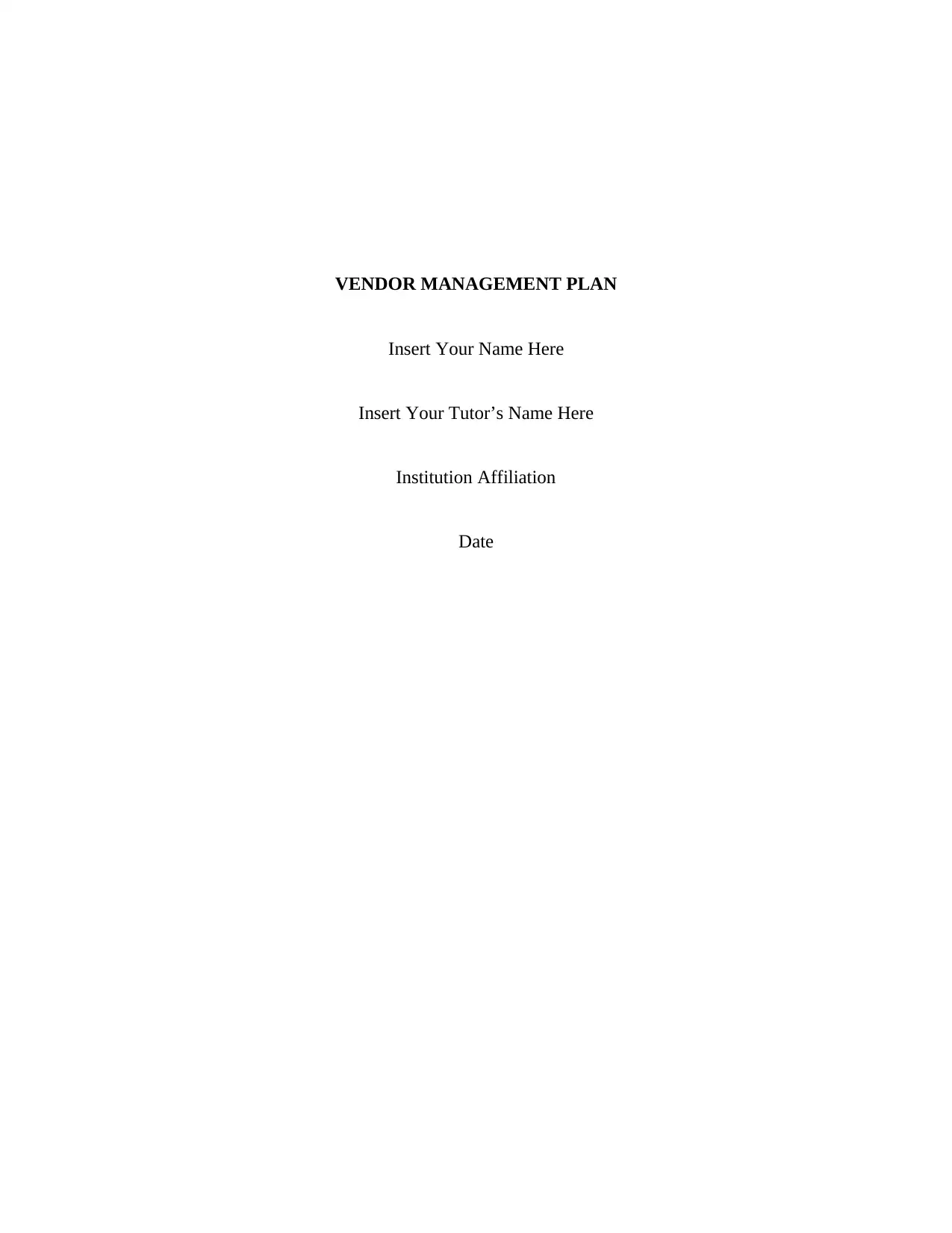
VENDOR MANAGEMENT PLAN
Insert Your Name Here
Insert Your Tutor’s Name Here
Institution Affiliation
Date
Insert Your Name Here
Insert Your Tutor’s Name Here
Institution Affiliation
Date
Paraphrase This Document
Need a fresh take? Get an instant paraphrase of this document with our AI Paraphraser
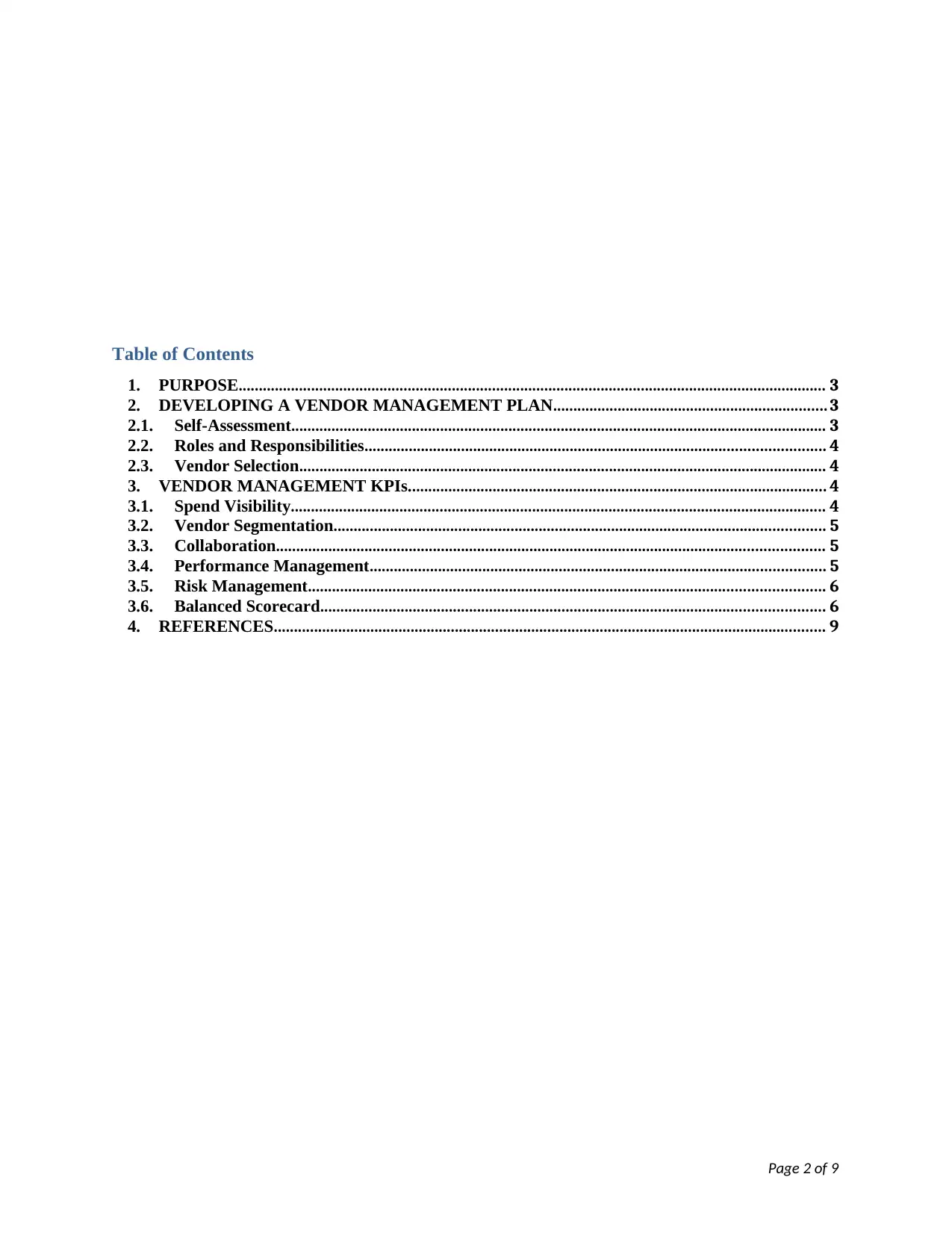
Table of Contents
1. PURPOSE.................................................................................................................................................. 3
2. DEVELOPING A VENDOR MANAGEMENT PLAN....................................................................3
2.1. Self-Assessment..................................................................................................................................... 3
2.2. Roles and Responsibilities.................................................................................................................. 4
2.3. Vendor Selection................................................................................................................................... 4
3. VENDOR MANAGEMENT KPIs........................................................................................................ 4
3.1. Spend Visibility..................................................................................................................................... 4
3.2. Vendor Segmentation.......................................................................................................................... 5
3.3. Collaboration........................................................................................................................................ 5
3.4. Performance Management................................................................................................................. 5
3.5. Risk Management................................................................................................................................ 6
3.6. Balanced Scorecard............................................................................................................................. 6
4. REFERENCES......................................................................................................................................... 9
Page 2 of 9
1. PURPOSE.................................................................................................................................................. 3
2. DEVELOPING A VENDOR MANAGEMENT PLAN....................................................................3
2.1. Self-Assessment..................................................................................................................................... 3
2.2. Roles and Responsibilities.................................................................................................................. 4
2.3. Vendor Selection................................................................................................................................... 4
3. VENDOR MANAGEMENT KPIs........................................................................................................ 4
3.1. Spend Visibility..................................................................................................................................... 4
3.2. Vendor Segmentation.......................................................................................................................... 5
3.3. Collaboration........................................................................................................................................ 5
3.4. Performance Management................................................................................................................. 5
3.5. Risk Management................................................................................................................................ 6
3.6. Balanced Scorecard............................................................................................................................. 6
4. REFERENCES......................................................................................................................................... 9
Page 2 of 9
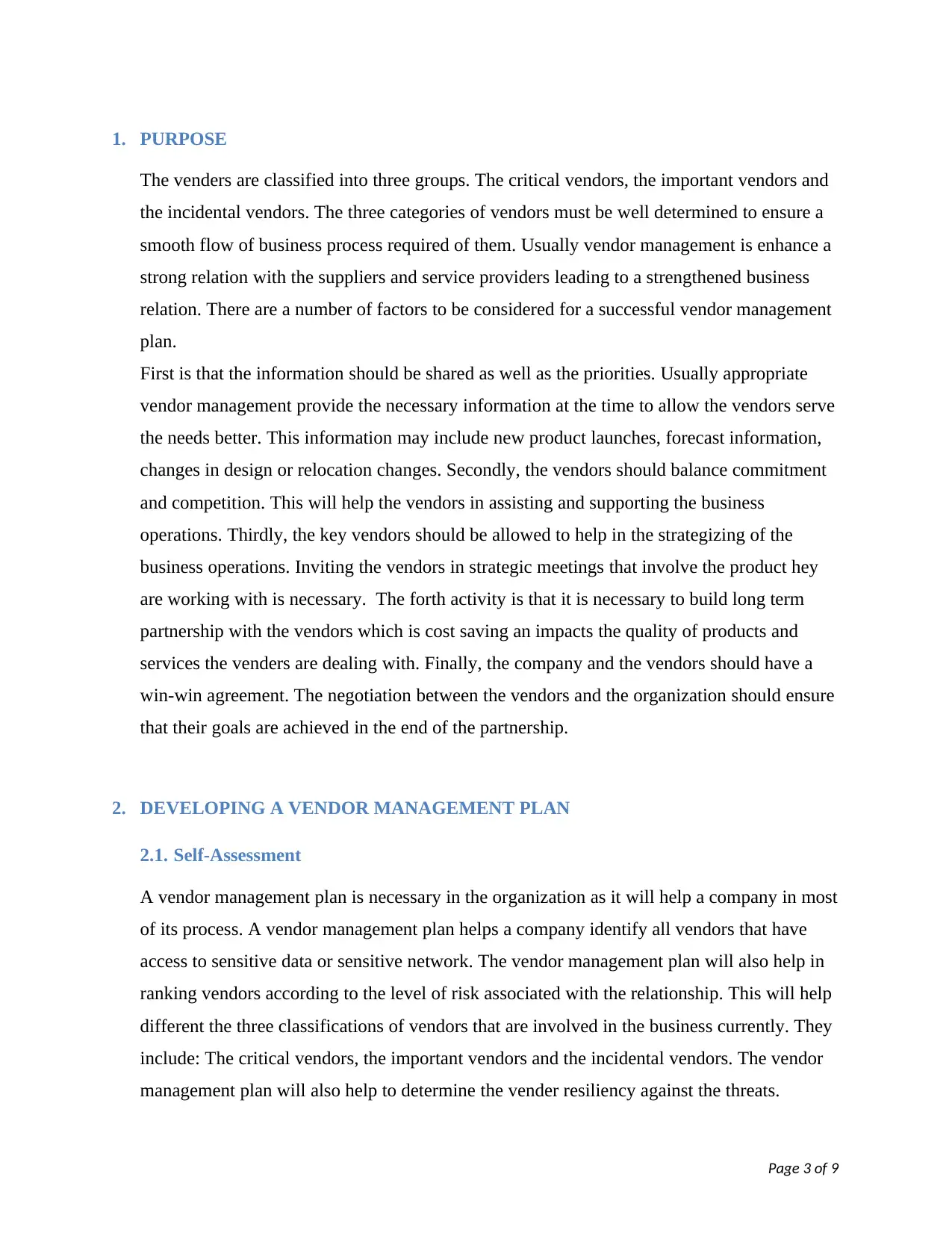
1. PURPOSE
The venders are classified into three groups. The critical vendors, the important vendors and
the incidental vendors. The three categories of vendors must be well determined to ensure a
smooth flow of business process required of them. Usually vendor management is enhance a
strong relation with the suppliers and service providers leading to a strengthened business
relation. There are a number of factors to be considered for a successful vendor management
plan.
First is that the information should be shared as well as the priorities. Usually appropriate
vendor management provide the necessary information at the time to allow the vendors serve
the needs better. This information may include new product launches, forecast information,
changes in design or relocation changes. Secondly, the vendors should balance commitment
and competition. This will help the vendors in assisting and supporting the business
operations. Thirdly, the key vendors should be allowed to help in the strategizing of the
business operations. Inviting the vendors in strategic meetings that involve the product hey
are working with is necessary. The forth activity is that it is necessary to build long term
partnership with the vendors which is cost saving an impacts the quality of products and
services the venders are dealing with. Finally, the company and the vendors should have a
win-win agreement. The negotiation between the vendors and the organization should ensure
that their goals are achieved in the end of the partnership.
2. DEVELOPING A VENDOR MANAGEMENT PLAN
2.1. Self-Assessment
A vendor management plan is necessary in the organization as it will help a company in most
of its process. A vendor management plan helps a company identify all vendors that have
access to sensitive data or sensitive network. The vendor management plan will also help in
ranking vendors according to the level of risk associated with the relationship. This will help
different the three classifications of vendors that are involved in the business currently. They
include: The critical vendors, the important vendors and the incidental vendors. The vendor
management plan will also help to determine the vender resiliency against the threats.
Page 3 of 9
The venders are classified into three groups. The critical vendors, the important vendors and
the incidental vendors. The three categories of vendors must be well determined to ensure a
smooth flow of business process required of them. Usually vendor management is enhance a
strong relation with the suppliers and service providers leading to a strengthened business
relation. There are a number of factors to be considered for a successful vendor management
plan.
First is that the information should be shared as well as the priorities. Usually appropriate
vendor management provide the necessary information at the time to allow the vendors serve
the needs better. This information may include new product launches, forecast information,
changes in design or relocation changes. Secondly, the vendors should balance commitment
and competition. This will help the vendors in assisting and supporting the business
operations. Thirdly, the key vendors should be allowed to help in the strategizing of the
business operations. Inviting the vendors in strategic meetings that involve the product hey
are working with is necessary. The forth activity is that it is necessary to build long term
partnership with the vendors which is cost saving an impacts the quality of products and
services the venders are dealing with. Finally, the company and the vendors should have a
win-win agreement. The negotiation between the vendors and the organization should ensure
that their goals are achieved in the end of the partnership.
2. DEVELOPING A VENDOR MANAGEMENT PLAN
2.1. Self-Assessment
A vendor management plan is necessary in the organization as it will help a company in most
of its process. A vendor management plan helps a company identify all vendors that have
access to sensitive data or sensitive network. The vendor management plan will also help in
ranking vendors according to the level of risk associated with the relationship. This will help
different the three classifications of vendors that are involved in the business currently. They
include: The critical vendors, the important vendors and the incidental vendors. The vendor
management plan will also help to determine the vender resiliency against the threats.
Page 3 of 9
⊘ This is a preview!⊘
Do you want full access?
Subscribe today to unlock all pages.

Trusted by 1+ million students worldwide
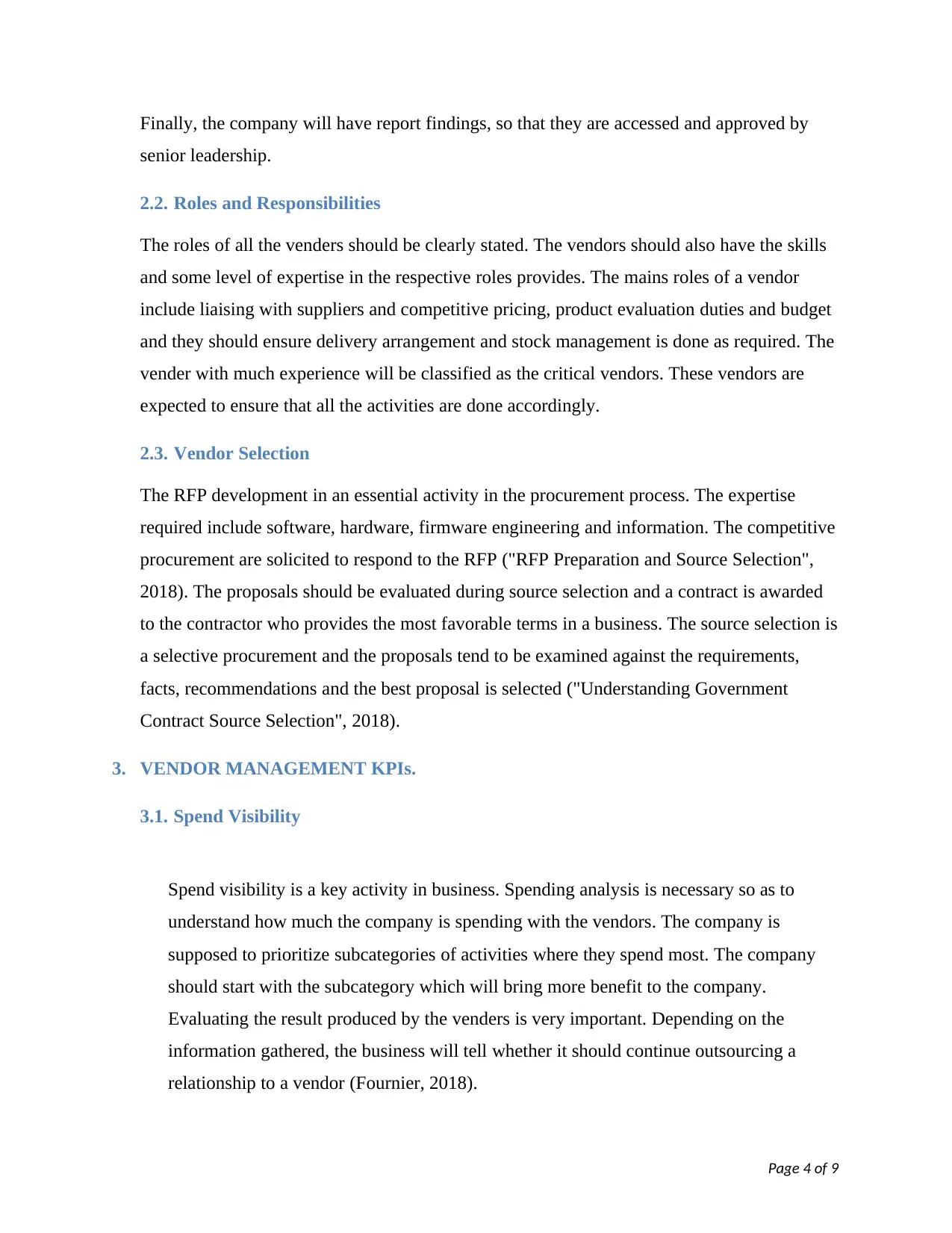
Finally, the company will have report findings, so that they are accessed and approved by
senior leadership.
2.2. Roles and Responsibilities
The roles of all the venders should be clearly stated. The vendors should also have the skills
and some level of expertise in the respective roles provides. The mains roles of a vendor
include liaising with suppliers and competitive pricing, product evaluation duties and budget
and they should ensure delivery arrangement and stock management is done as required. The
vender with much experience will be classified as the critical vendors. These vendors are
expected to ensure that all the activities are done accordingly.
2.3. Vendor Selection
The RFP development in an essential activity in the procurement process. The expertise
required include software, hardware, firmware engineering and information. The competitive
procurement are solicited to respond to the RFP ("RFP Preparation and Source Selection",
2018). The proposals should be evaluated during source selection and a contract is awarded
to the contractor who provides the most favorable terms in a business. The source selection is
a selective procurement and the proposals tend to be examined against the requirements,
facts, recommendations and the best proposal is selected ("Understanding Government
Contract Source Selection", 2018).
3. VENDOR MANAGEMENT KPIs.
3.1. Spend Visibility
Spend visibility is a key activity in business. Spending analysis is necessary so as to
understand how much the company is spending with the vendors. The company is
supposed to prioritize subcategories of activities where they spend most. The company
should start with the subcategory which will bring more benefit to the company.
Evaluating the result produced by the venders is very important. Depending on the
information gathered, the business will tell whether it should continue outsourcing a
relationship to a vendor (Fournier, 2018).
Page 4 of 9
senior leadership.
2.2. Roles and Responsibilities
The roles of all the venders should be clearly stated. The vendors should also have the skills
and some level of expertise in the respective roles provides. The mains roles of a vendor
include liaising with suppliers and competitive pricing, product evaluation duties and budget
and they should ensure delivery arrangement and stock management is done as required. The
vender with much experience will be classified as the critical vendors. These vendors are
expected to ensure that all the activities are done accordingly.
2.3. Vendor Selection
The RFP development in an essential activity in the procurement process. The expertise
required include software, hardware, firmware engineering and information. The competitive
procurement are solicited to respond to the RFP ("RFP Preparation and Source Selection",
2018). The proposals should be evaluated during source selection and a contract is awarded
to the contractor who provides the most favorable terms in a business. The source selection is
a selective procurement and the proposals tend to be examined against the requirements,
facts, recommendations and the best proposal is selected ("Understanding Government
Contract Source Selection", 2018).
3. VENDOR MANAGEMENT KPIs.
3.1. Spend Visibility
Spend visibility is a key activity in business. Spending analysis is necessary so as to
understand how much the company is spending with the vendors. The company is
supposed to prioritize subcategories of activities where they spend most. The company
should start with the subcategory which will bring more benefit to the company.
Evaluating the result produced by the venders is very important. Depending on the
information gathered, the business will tell whether it should continue outsourcing a
relationship to a vendor (Fournier, 2018).
Page 4 of 9
Paraphrase This Document
Need a fresh take? Get an instant paraphrase of this document with our AI Paraphraser
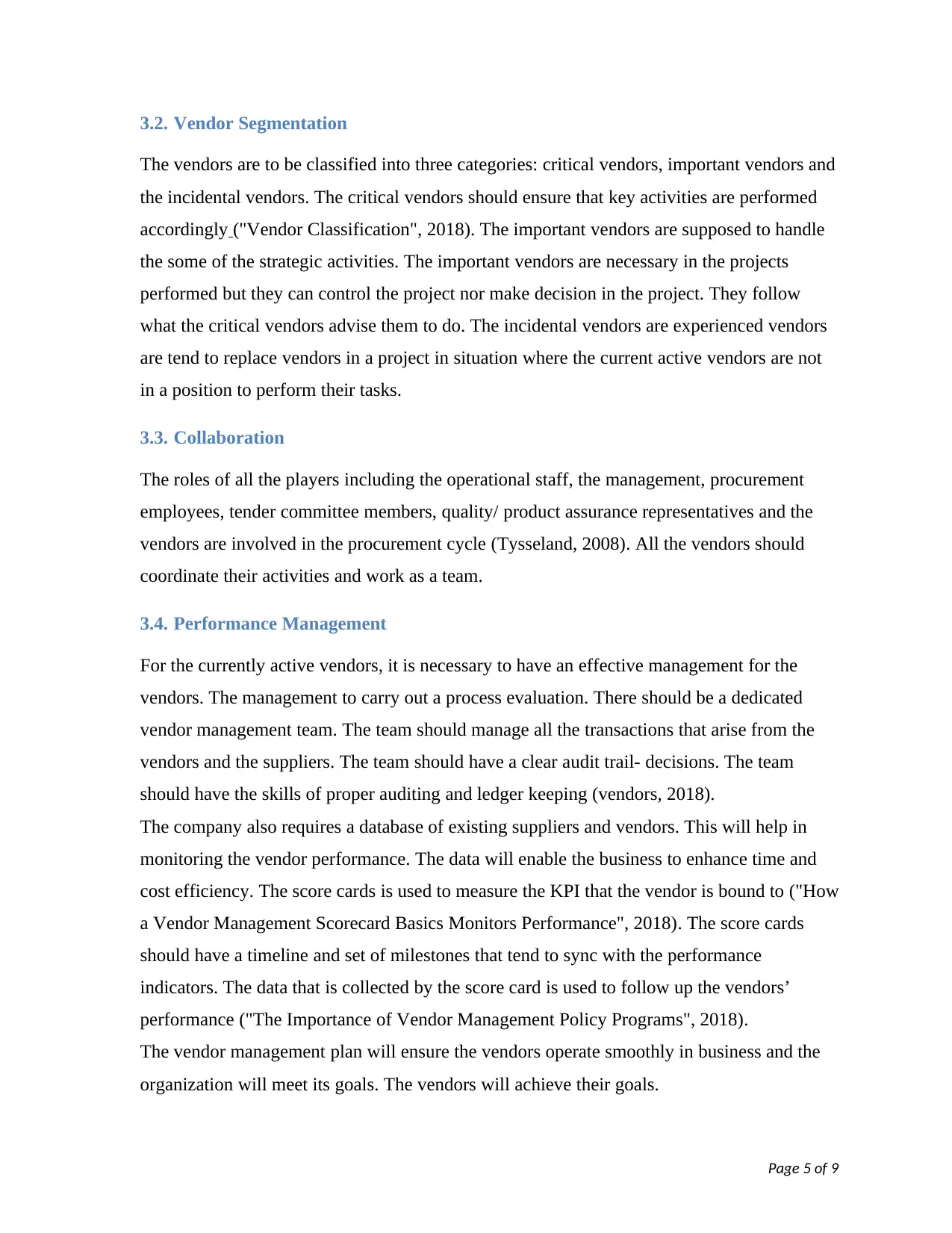
3.2. Vendor Segmentation
The vendors are to be classified into three categories: critical vendors, important vendors and
the incidental vendors. The critical vendors should ensure that key activities are performed
accordingly ("Vendor Classification", 2018). The important vendors are supposed to handle
the some of the strategic activities. The important vendors are necessary in the projects
performed but they can control the project nor make decision in the project. They follow
what the critical vendors advise them to do. The incidental vendors are experienced vendors
are tend to replace vendors in a project in situation where the current active vendors are not
in a position to perform their tasks.
3.3. Collaboration
The roles of all the players including the operational staff, the management, procurement
employees, tender committee members, quality/ product assurance representatives and the
vendors are involved in the procurement cycle (Tysseland, 2008). All the vendors should
coordinate their activities and work as a team.
3.4. Performance Management
For the currently active vendors, it is necessary to have an effective management for the
vendors. The management to carry out a process evaluation. There should be a dedicated
vendor management team. The team should manage all the transactions that arise from the
vendors and the suppliers. The team should have a clear audit trail- decisions. The team
should have the skills of proper auditing and ledger keeping (vendors, 2018).
The company also requires a database of existing suppliers and vendors. This will help in
monitoring the vendor performance. The data will enable the business to enhance time and
cost efficiency. The score cards is used to measure the KPI that the vendor is bound to ("How
a Vendor Management Scorecard Basics Monitors Performance", 2018). The score cards
should have a timeline and set of milestones that tend to sync with the performance
indicators. The data that is collected by the score card is used to follow up the vendors’
performance ("The Importance of Vendor Management Policy Programs", 2018).
The vendor management plan will ensure the vendors operate smoothly in business and the
organization will meet its goals. The vendors will achieve their goals.
Page 5 of 9
The vendors are to be classified into three categories: critical vendors, important vendors and
the incidental vendors. The critical vendors should ensure that key activities are performed
accordingly ("Vendor Classification", 2018). The important vendors are supposed to handle
the some of the strategic activities. The important vendors are necessary in the projects
performed but they can control the project nor make decision in the project. They follow
what the critical vendors advise them to do. The incidental vendors are experienced vendors
are tend to replace vendors in a project in situation where the current active vendors are not
in a position to perform their tasks.
3.3. Collaboration
The roles of all the players including the operational staff, the management, procurement
employees, tender committee members, quality/ product assurance representatives and the
vendors are involved in the procurement cycle (Tysseland, 2008). All the vendors should
coordinate their activities and work as a team.
3.4. Performance Management
For the currently active vendors, it is necessary to have an effective management for the
vendors. The management to carry out a process evaluation. There should be a dedicated
vendor management team. The team should manage all the transactions that arise from the
vendors and the suppliers. The team should have a clear audit trail- decisions. The team
should have the skills of proper auditing and ledger keeping (vendors, 2018).
The company also requires a database of existing suppliers and vendors. This will help in
monitoring the vendor performance. The data will enable the business to enhance time and
cost efficiency. The score cards is used to measure the KPI that the vendor is bound to ("How
a Vendor Management Scorecard Basics Monitors Performance", 2018). The score cards
should have a timeline and set of milestones that tend to sync with the performance
indicators. The data that is collected by the score card is used to follow up the vendors’
performance ("The Importance of Vendor Management Policy Programs", 2018).
The vendor management plan will ensure the vendors operate smoothly in business and the
organization will meet its goals. The vendors will achieve their goals.
Page 5 of 9
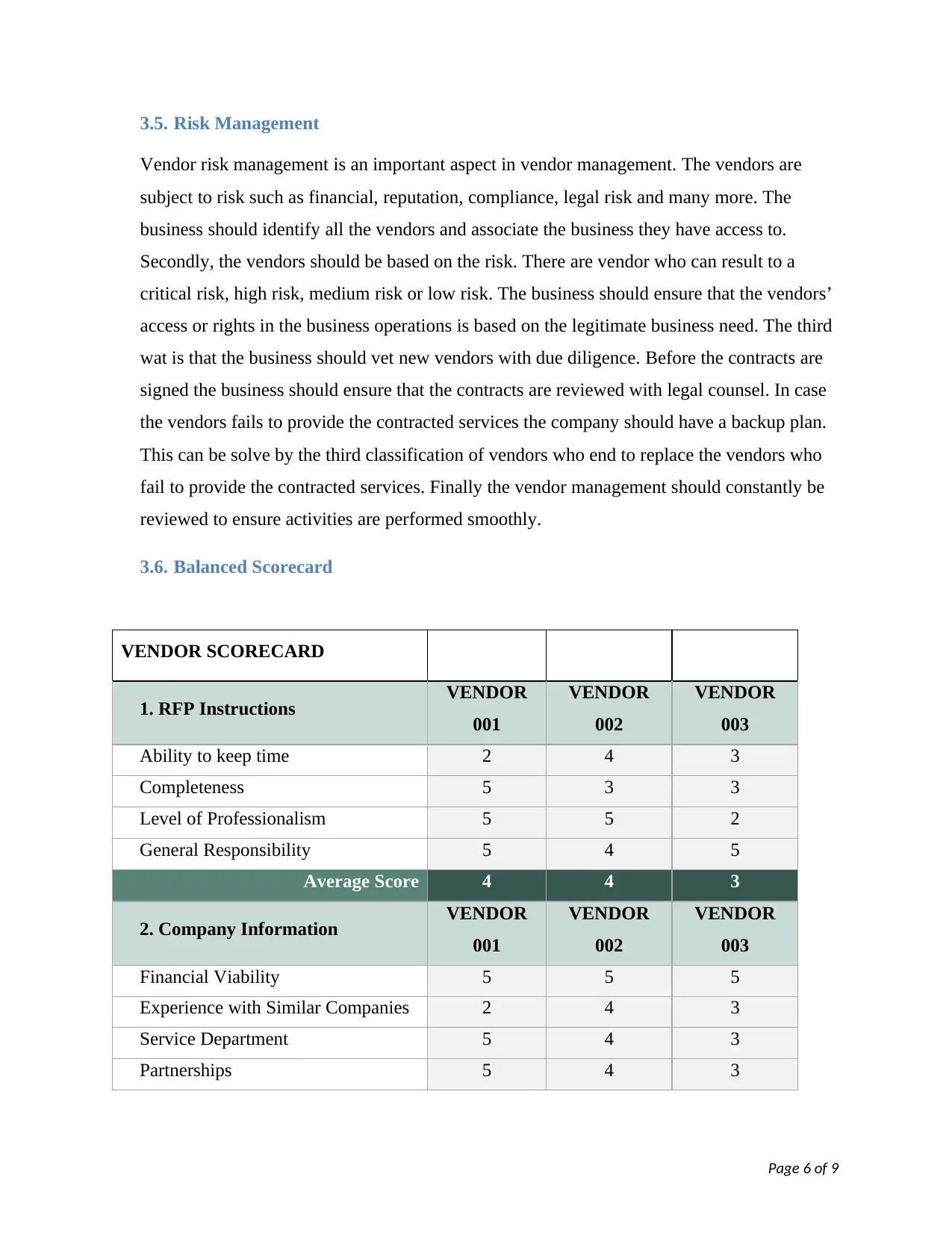
3.5. Risk Management
Vendor risk management is an important aspect in vendor management. The vendors are
subject to risk such as financial, reputation, compliance, legal risk and many more. The
business should identify all the vendors and associate the business they have access to.
Secondly, the vendors should be based on the risk. There are vendor who can result to a
critical risk, high risk, medium risk or low risk. The business should ensure that the vendors’
access or rights in the business operations is based on the legitimate business need. The third
wat is that the business should vet new vendors with due diligence. Before the contracts are
signed the business should ensure that the contracts are reviewed with legal counsel. In case
the vendors fails to provide the contracted services the company should have a backup plan.
This can be solve by the third classification of vendors who end to replace the vendors who
fail to provide the contracted services. Finally the vendor management should constantly be
reviewed to ensure activities are performed smoothly.
3.6. Balanced Scorecard
VENDOR SCORECARD
1. RFP Instructions VENDOR
001
VENDOR
002
VENDOR
003
Ability to keep time 2 4 3
Completeness 5 3 3
Level of Professionalism 5 5 2
General Responsibility 5 4 5
Average Score 4 4 3
2. Company Information VENDOR
001
VENDOR
002
VENDOR
003
Financial Viability 5 5 5
Experience with Similar Companies 2 4 3
Service Department 5 4 3
Partnerships 5 4 3
Page 6 of 9
Vendor risk management is an important aspect in vendor management. The vendors are
subject to risk such as financial, reputation, compliance, legal risk and many more. The
business should identify all the vendors and associate the business they have access to.
Secondly, the vendors should be based on the risk. There are vendor who can result to a
critical risk, high risk, medium risk or low risk. The business should ensure that the vendors’
access or rights in the business operations is based on the legitimate business need. The third
wat is that the business should vet new vendors with due diligence. Before the contracts are
signed the business should ensure that the contracts are reviewed with legal counsel. In case
the vendors fails to provide the contracted services the company should have a backup plan.
This can be solve by the third classification of vendors who end to replace the vendors who
fail to provide the contracted services. Finally the vendor management should constantly be
reviewed to ensure activities are performed smoothly.
3.6. Balanced Scorecard
VENDOR SCORECARD
1. RFP Instructions VENDOR
001
VENDOR
002
VENDOR
003
Ability to keep time 2 4 3
Completeness 5 3 3
Level of Professionalism 5 5 2
General Responsibility 5 4 5
Average Score 4 4 3
2. Company Information VENDOR
001
VENDOR
002
VENDOR
003
Financial Viability 5 5 5
Experience with Similar Companies 2 4 3
Service Department 5 4 3
Partnerships 5 4 3
Page 6 of 9
⊘ This is a preview!⊘
Do you want full access?
Subscribe today to unlock all pages.

Trusted by 1+ million students worldwide
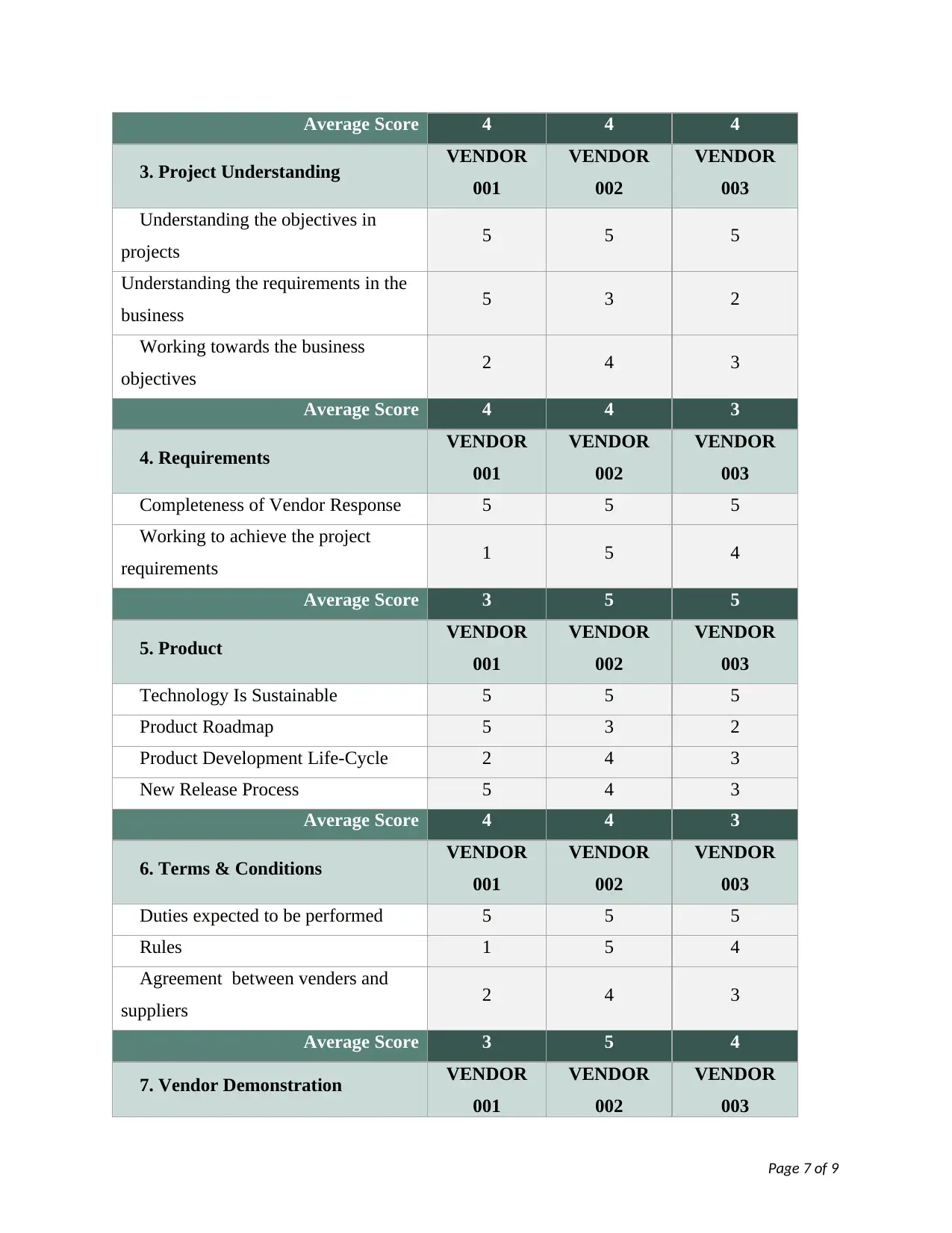
Average Score 4 4 4
3. Project Understanding VENDOR
001
VENDOR
002
VENDOR
003
Understanding the objectives in
projects 5 5 5
Understanding the requirements in the
business 5 3 2
Working towards the business
objectives 2 4 3
Average Score 4 4 3
4. Requirements VENDOR
001
VENDOR
002
VENDOR
003
Completeness of Vendor Response 5 5 5
Working to achieve the project
requirements 1 5 4
Average Score 3 5 5
5. Product VENDOR
001
VENDOR
002
VENDOR
003
Technology Is Sustainable 5 5 5
Product Roadmap 5 3 2
Product Development Life-Cycle 2 4 3
New Release Process 5 4 3
Average Score 4 4 3
6. Terms & Conditions VENDOR
001
VENDOR
002
VENDOR
003
Duties expected to be performed 5 5 5
Rules 1 5 4
Agreement between venders and
suppliers 2 4 3
Average Score 3 5 4
7. Vendor Demonstration VENDOR
001
VENDOR
002
VENDOR
003
Page 7 of 9
3. Project Understanding VENDOR
001
VENDOR
002
VENDOR
003
Understanding the objectives in
projects 5 5 5
Understanding the requirements in the
business 5 3 2
Working towards the business
objectives 2 4 3
Average Score 4 4 3
4. Requirements VENDOR
001
VENDOR
002
VENDOR
003
Completeness of Vendor Response 5 5 5
Working to achieve the project
requirements 1 5 4
Average Score 3 5 5
5. Product VENDOR
001
VENDOR
002
VENDOR
003
Technology Is Sustainable 5 5 5
Product Roadmap 5 3 2
Product Development Life-Cycle 2 4 3
New Release Process 5 4 3
Average Score 4 4 3
6. Terms & Conditions VENDOR
001
VENDOR
002
VENDOR
003
Duties expected to be performed 5 5 5
Rules 1 5 4
Agreement between venders and
suppliers 2 4 3
Average Score 3 5 4
7. Vendor Demonstration VENDOR
001
VENDOR
002
VENDOR
003
Page 7 of 9
Paraphrase This Document
Need a fresh take? Get an instant paraphrase of this document with our AI Paraphraser
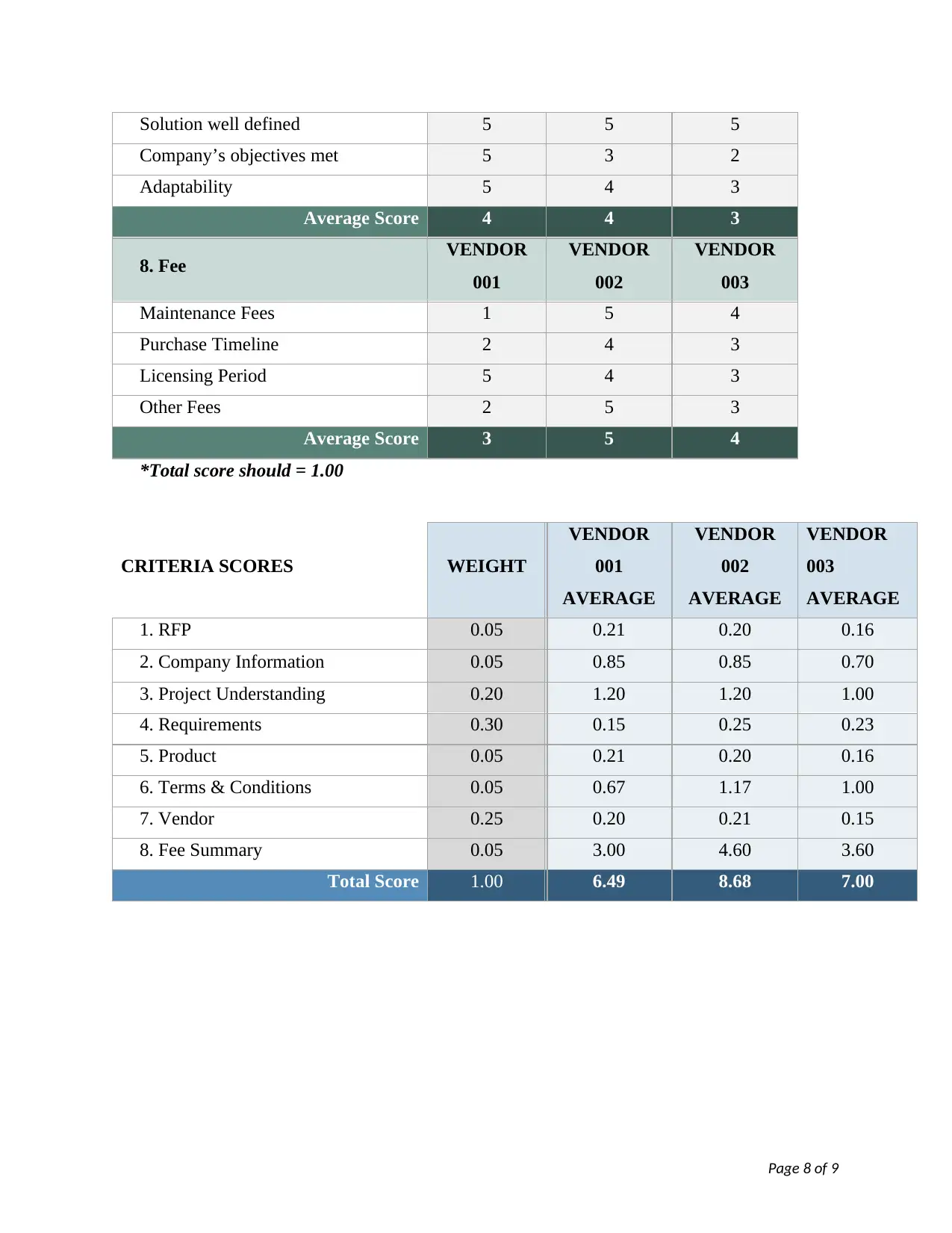
Solution well defined 5 5 5
Company’s objectives met 5 3 2
Adaptability 5 4 3
Average Score 4 4 3
8. Fee VENDOR
001
VENDOR
002
VENDOR
003
Maintenance Fees 1 5 4
Purchase Timeline 2 4 3
Licensing Period 5 4 3
Other Fees 2 5 3
Average Score 3 5 4
*Total score should = 1.00
CRITERIA SCORES WEIGHT
VENDOR
001
AVERAGE
VENDOR
002
AVERAGE
VENDOR
003
AVERAGE
1. RFP 0.05 0.21 0.20 0.16
2. Company Information 0.05 0.85 0.85 0.70
3. Project Understanding 0.20 1.20 1.20 1.00
4. Requirements 0.30 0.15 0.25 0.23
5. Product 0.05 0.21 0.20 0.16
6. Terms & Conditions 0.05 0.67 1.17 1.00
7. Vendor 0.25 0.20 0.21 0.15
8. Fee Summary 0.05 3.00 4.60 3.60
Total Score 1.00 6.49 8.68 7.00
Page 8 of 9
Company’s objectives met 5 3 2
Adaptability 5 4 3
Average Score 4 4 3
8. Fee VENDOR
001
VENDOR
002
VENDOR
003
Maintenance Fees 1 5 4
Purchase Timeline 2 4 3
Licensing Period 5 4 3
Other Fees 2 5 3
Average Score 3 5 4
*Total score should = 1.00
CRITERIA SCORES WEIGHT
VENDOR
001
AVERAGE
VENDOR
002
AVERAGE
VENDOR
003
AVERAGE
1. RFP 0.05 0.21 0.20 0.16
2. Company Information 0.05 0.85 0.85 0.70
3. Project Understanding 0.20 1.20 1.20 1.00
4. Requirements 0.30 0.15 0.25 0.23
5. Product 0.05 0.21 0.20 0.16
6. Terms & Conditions 0.05 0.67 1.17 1.00
7. Vendor 0.25 0.20 0.21 0.15
8. Fee Summary 0.05 3.00 4.60 3.60
Total Score 1.00 6.49 8.68 7.00
Page 8 of 9
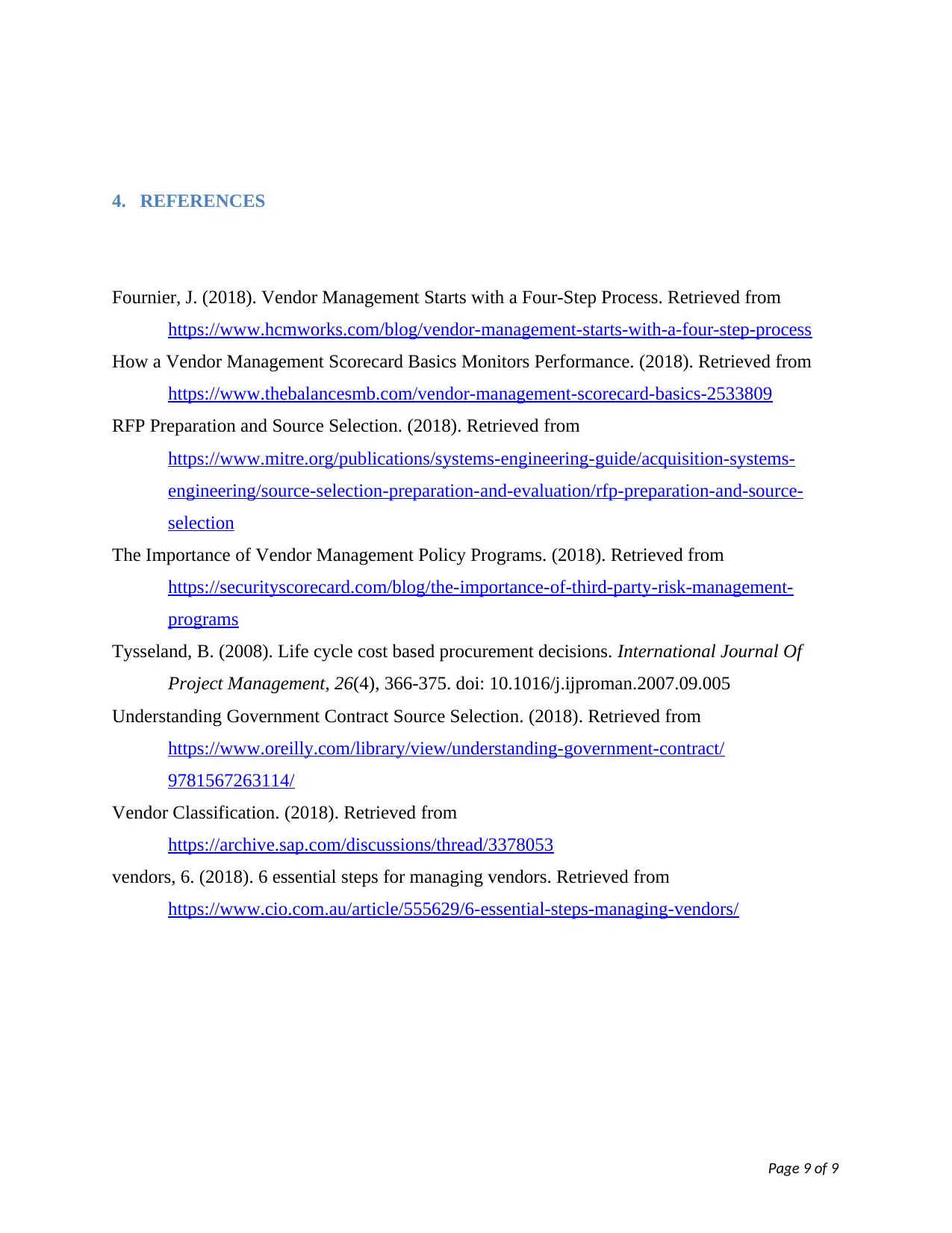
4. REFERENCES
Fournier, J. (2018). Vendor Management Starts with a Four-Step Process. Retrieved from
https://www.hcmworks.com/blog/vendor-management-starts-with-a-four-step-process
How a Vendor Management Scorecard Basics Monitors Performance. (2018). Retrieved from
https://www.thebalancesmb.com/vendor-management-scorecard-basics-2533809
RFP Preparation and Source Selection. (2018). Retrieved from
https://www.mitre.org/publications/systems-engineering-guide/acquisition-systems-
engineering/source-selection-preparation-and-evaluation/rfp-preparation-and-source-
selection
The Importance of Vendor Management Policy Programs. (2018). Retrieved from
https://securityscorecard.com/blog/the-importance-of-third-party-risk-management-
programs
Tysseland, B. (2008). Life cycle cost based procurement decisions. International Journal Of
Project Management, 26(4), 366-375. doi: 10.1016/j.ijproman.2007.09.005
Understanding Government Contract Source Selection. (2018). Retrieved from
https://www.oreilly.com/library/view/understanding-government-contract/
9781567263114/
Vendor Classification. (2018). Retrieved from
https://archive.sap.com/discussions/thread/3378053
vendors, 6. (2018). 6 essential steps for managing vendors. Retrieved from
https://www.cio.com.au/article/555629/6-essential-steps-managing-vendors/
Page 9 of 9
Fournier, J. (2018). Vendor Management Starts with a Four-Step Process. Retrieved from
https://www.hcmworks.com/blog/vendor-management-starts-with-a-four-step-process
How a Vendor Management Scorecard Basics Monitors Performance. (2018). Retrieved from
https://www.thebalancesmb.com/vendor-management-scorecard-basics-2533809
RFP Preparation and Source Selection. (2018). Retrieved from
https://www.mitre.org/publications/systems-engineering-guide/acquisition-systems-
engineering/source-selection-preparation-and-evaluation/rfp-preparation-and-source-
selection
The Importance of Vendor Management Policy Programs. (2018). Retrieved from
https://securityscorecard.com/blog/the-importance-of-third-party-risk-management-
programs
Tysseland, B. (2008). Life cycle cost based procurement decisions. International Journal Of
Project Management, 26(4), 366-375. doi: 10.1016/j.ijproman.2007.09.005
Understanding Government Contract Source Selection. (2018). Retrieved from
https://www.oreilly.com/library/view/understanding-government-contract/
9781567263114/
Vendor Classification. (2018). Retrieved from
https://archive.sap.com/discussions/thread/3378053
vendors, 6. (2018). 6 essential steps for managing vendors. Retrieved from
https://www.cio.com.au/article/555629/6-essential-steps-managing-vendors/
Page 9 of 9
⊘ This is a preview!⊘
Do you want full access?
Subscribe today to unlock all pages.

Trusted by 1+ million students worldwide
1 out of 9
Related Documents
Your All-in-One AI-Powered Toolkit for Academic Success.
+13062052269
info@desklib.com
Available 24*7 on WhatsApp / Email
![[object Object]](/_next/static/media/star-bottom.7253800d.svg)
Unlock your academic potential
Copyright © 2020–2025 A2Z Services. All Rights Reserved. Developed and managed by ZUCOL.




